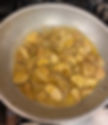November 12th Brandy Tasting (second of Four Articles...)
- gstrickland42
- Dec 3, 2021
- 3 min read
Updated: Dec 14, 2021

Château de Laubade Armagnac (Fr)
Spoon of Foie Gras Mousse
You really can't discuss brandy without acknowledging France. France has been producing brandies since at least the 1300's although it was early on considered a "medicine". Some of the most famous brandies in the world come from France, notably: Cognac, Calvados and Armagnac.
Armagnac is produced --unsurprisingly-- in Armagnac in the Gascony Region of France. Some French Brandies like cognac are double or triple distilled with more of the impurities removed which makes for a smoother more subtle taste (and less hangover according to some). That's why whiskey has a stronger taste than vodka, even before aging in oak. Armagnac is distilled once, which leads to a fuller/more complex flavor. The wine is made from relatively unknown grapes, and is surprisingly thin and undrinkable before distillation.

Our Armagnac is from the Bas Armagnac region specifically and is produced on 260 acres of sustainably-farmed vineyards dating back to the 1870's. The aroma was milder than the Spanish Brandy we had, and the flavor had a very definite prune or even currant flavor. A little much on it's own, but it is of course an acquired taste. Brandy in any form is a very rich and powerful flavor and demands an accompaniment to match its stature.
Of course, the chef had no choice but to reach for the Foie Gras...

Foie Gras is quite simply the food of the gods.
When waterfowl such as geese or ducks prepare for winter, they have the ability to eat enormous amounts of food in a short period of time. Their gullets are capable of stretching allowing them to eat and breathe at the same time. As early as the ancient Egyptians, it was noticed that ducks and geese who were force-fed grains during this time would put on quite a bit of weight, and notably the liver would swell with fat. The name "Foie Gras" literally translates into "fat liver", but such an apt description does no justice to the wonderful texture and flavor of this expensive and delectable treat. The French have long mastered the production and use of Foie Gras but get a serious run for their money from the Hudson Valley region, the source of most American foie gras.
To match such a brandy, we chose a spoonful of mousse, made from foie gras and cream.

First, the liver is cleaned of any discolorations, diced and marinated in Armagnac, honey and Marsala overnight. here we see it draining before use.
Don't worry, it gets better.
So once the liquid has drained away it is laid on a dry towel to remove any further moisture. A sauté pan is heated to very hot.

Note the salt in the hot pan. I don't like to season the foie directly, as the salt can draw moisture to the surface if left too long. You want the liver to be fairly dry.

The foie is added to the hot pan, and quickly sautéed. One must be careful with this ingredient, the high fat content means that your very expensive Foie Gras can literally melt if you are not careful.

The idea here is to get a good sear. Food scientists would call this the Maillard Reaction, chefs simply know that this concentration of flavors is the key to success.

After about a minute the cooking is done. I poured the mixture, including the fat into a bowl sitting in ice to quickly stop the cooking process. then it was spooned into a food processor. and puréed.

Whipped cream is folded in. Some chefs use butter, but really, I though we had enough fat for one dish...
Taste and check seasonings... delicious. Of course I ended up making way too much for the tasting, so the kitchen crew ate well...

The texture is rich and silky, the flavor like buttery cream, with a sweetness like caramelized fruit in the background.
After the foie gras the Armagnac was much more approachable and the toastiness of the French oak more perceptible.
Up next; Pear Brandy ...


